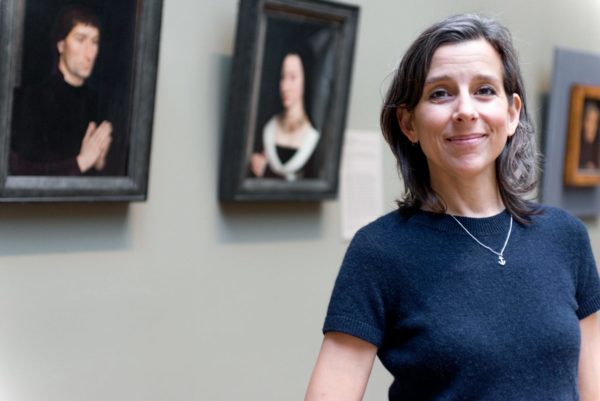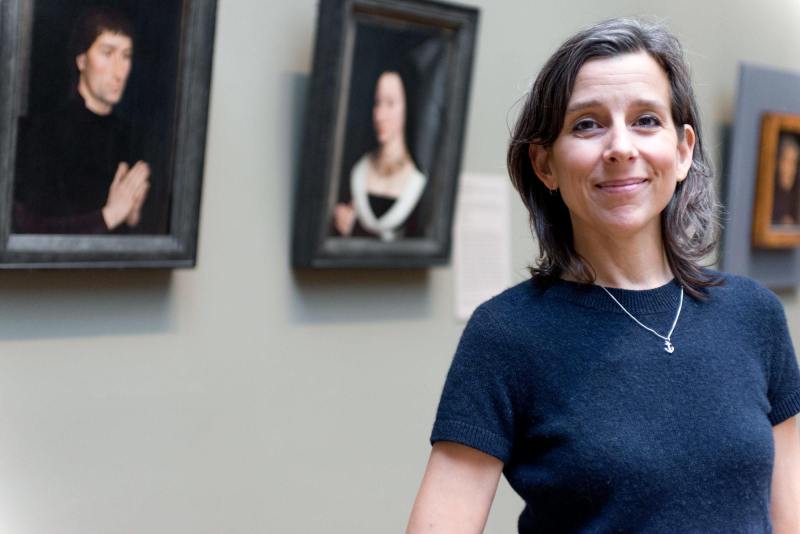
“You are the only member of this conference.” A pre-recorded voice echoed this phrase in the small, oval auditorium of the Cantor Arts Center. With only a few lights casting neon shadows onto the shifting crowd, artist Nina Katchadourian stood front and center alongside DJ Shakey and DJ Stylus spinning for her “On Hold Music Dance Party” this past Thursday — a dance party with music mixed entirely from sounds recorded from phone calls while placed on hold. By the number of people in the same room as me, I clearly was not by myself, yet for that hour, I felt oddly alone and engulfed in Katchadourian’s music.
After biking through rain and wandering Cantor for a few minutes searching for the auditorium, I entered to a room somewhat small and somewhat full of people. There was no music yet. Notebook in one hand and pen in the other, I clung to the side wall as a woman ushered people in and the three DJs emerged from a curtain, all similarly dressed in white button-ups, ties and glasses.
A surprisingly few number of undergraduate students were in the room. In fact, most of the crowd appeared to be in their 50s. A girl next to me leaned over to her partner and mumbled, “This might be more of like a middle school dance,” and I wondered for a moment if that would be true. To my delight, however, the crowd and setlist proved to be enjoyable and unexpectedly contemplative.
The first ten minutes were what I would describe as being the soundtrack to my existential crisis. A mixture of beeping, dial tones and elevator music emanated throughout the room. With this softer beginning, I hovered near the wall, unsure of how to dance while scribbling notes I could barely see. At the first “you are the only member of this conference,” the room let out a collective chuckle, and a few more people joined the dancing. A few couples began to partner dance, and others swayed awkwardly, looking around and deciding what to do. Two sisters, both around ten, occupied the middle of the floor, jumping and laughing together.
After a few more reminders of our lonely conferences, Katchadourian ramped up the music’s intensity, and in anticipation of a bass drop, she instead dropped into an upbeat mariachi tune. Finally, the room’s tension eased. Groups of people left their voyeuristic state, abandoning the safety of the wall and joining the eclectic, energetic dancing at the center of the floor.
I stood at the edge a bit longer, still pondering the solitude of my conference while the music’s beat picked up and the room’s volume grew. Through Katchadourian’s dream-like combination of distorted, mechanical messages and robotic patterns of beeping, I felt introspective yet incredibly connected to this gathering of strangers — all we had in common was Katchadourian’s music. An older, well-dressed woman separated from the crowd for a moment, approaching her friend next to me and exclaiming, “Whose on-hold music is this?” before laughing and rejoining the pit.
In the end, it did not really matter who or where Katchadourian found her music. Her voice, somewhat hesitant, echoed repeatedly through the room as she asks an unidentified phone number, “I am wondering if I can listen to your on-hold music?” Her set felt less of a party and far more like performance art; the event was advertised as a party, a celebration of Katchadourian’s “Curiouser” exhibit, but it seemed to carry the same sentiment and invitation for contemplation that modern art does. These anonymous yet nostalgically familiar recordings were a collection of memories; each person had their individual, irreplicable recollections, but their outlines and generalities were all the same. Whether through dancing or through watching, Katchadourian created a moment in space to remember and to remember to enjoy ourselves in all its simplicity.
I would be the last person to consider myself a dancer, but as the wall vibrated more and more alongside the speakers, I felt compelled to also abandon my voyeuristic state. Despite my lack of large pockets, I tucked away my notes and half-danced, half-shuffled my way towards the middle. I came to this event alone, and I had a blast dancing alone. It was nothing like a middle school dance. Instead, I could think about the purpose of life and have a great time dancing.
Contact Julia Gordon at jmgordon ‘at’ stanford.edu.
